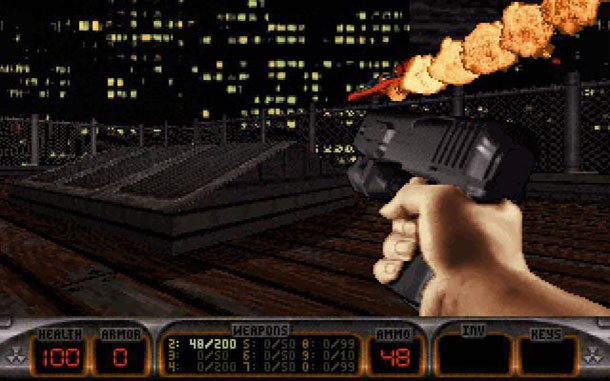Duke Nukem 3D Was (And Is) Awesome, And Here’s Why

Last Friday, Gearbox announced that it was bringing Duke Nukem back via Duke Nukem 3D: 20th Anniversary Edition World Tour. Players whose were introduced to the character via his disappointing last game likely laughed and moved on. “Who cares? He’s an unfunny relic who uses a turd like a pencil,” said some guy I just invented for the sake of my argument. Let’s forget that Duke Nukem Forever never came out, which is a thought experiment that should be quite easy. Duke Nukem 3D was one of the best shooters of its era by a significant margin, slapping its peers senseless when it came to weapon variety, level design, gameplay, and overall technical sophistication. If you didn’t check it out when it first arrived two decades ago, let me explain what exactly you missed out on.
Duke 3D arrived on the scene in January 1996, a couple of years after Doom’s debut. To say that Duke 3D advanced what id had done with its shooter would be an understatement. Developer 3D Realms created an incredibly sophisticated game, which is easily lost amid the clutter of pop-culture references and pixelated strippers. It was a showcase for the Build engine, which was later used in Shadow Warrior and Blood. What set the engine apart from other games at the time is how it allowed level designers to create rooms with variable heights and rooms that were stacked above other rooms. It wasn’t truly 3D, but compared to other games from that time period, the varied geometry was revelatory.
Thanks to some other technical trickery, Duke 3D included functional mirrors – something that’s still a rarity in gaming. It’s an incredibly small detail, but considering how frequently contemporary games have bathrooms with shattered or fogged-up mirrors to work around reflections, it still feels like a big leap. The game’s gore wasn’t anything particularly new – Doom and Mortal Kombat had been released, after all – so watching Pig Cops explode into crimson heaps didn’t move the needle by itself. The shock of seeing characters walking through the corpses and leaving bloody footprints for a few steps afterward, however, did.

My favorite games have something in common: They anticipate what the player might do, and reward them for trying it. On that front, Duke Nukem 3D was a triumph. Squish an enemy with a collapsing ceiling, and their guts would extend like an accordion when the ceiling snapped back into place. Jetpack a ridiculous height, and you might find a hidden weapon. Jump onto a pool table, and you could kick the balls around. One of my favorite things was firing a rocket into a teleporter after an opponent fled into it – the projectile would follow through to the other side, and, if you were lucky, it would score you an unseen kill.
Duke’s multiplayer was another phenomenal part of the game. It had a great blend of weapon variety and level design that worked perfectly in tandem. My roommate at the time and I spent countless hours playing the game’s first level, Hollywood Holocaust. It was set in a run-down part of town, with an adult theater as its focal point. (I’ll fully admit that the game’s juvenile humor may not have aged as well as the rest of the game.) That level – which was freely available as a try-before-you-buy shareware strategy – was unbelievably great. There were plenty of places to explore, and loads of secret items and weapons to discover. More important was how effective the sound design aided the experience.
Nearly every door in that level made a different sound when opened, which made it possible to pinpoint the locations of your opponents. It was a great reward for players who spent a lot of time playing the game, though it also had a tendency to make people rage quit. Oh well. If you were able to know where your opponents were, you could anticipate their route and set traps. Duke had traditional weapons such as handguns and shotguns, but his arsenal also included things like tripwire mines and pipe bombs – perfect for turning your foe’s trip through ductwork or in a hidden room into a surprise kill.

Duke’s quips may not have aged super well, but the tone was refreshing at the time. Here was a game with functional shrink-ray weapons and guns that could freeze enemies in place – where they could be stomped on or shattered, respectively. Duke seemed like a pretty cool guy, or at the very least he was familiar with the Evil Dead movies and They Live. Easter eggs were also scattered around, lampooning Doom, Aliens, and other big names. Doom never took itself seriously, but Duke seemed like the whole game was in on the joke as well – even if some of it bordered on dad-joke levels of comedy.
After Duke 3D, we all know what happened. Duke Nukem Forever was announced, then delayed, then apparently fell into a stasis chamber. When Gearbox finally released it a dozen or so years after it was announced, it felt like what it was: a game from a dozen years ago. Games moved on, and the genre evolved. The character himself may feel dated and hokey, but Duke 3D’s gameplay still holds up – particularly the multiplayer. That’s something that the GoldenEye 007s of the world can’t claim with a straight face.

Get the Game Informer Print Edition!
Explore your favorite games in premium print format, delivered to your door.
- 10 issues per year
- Only $4.80 per issue
- Full digital magazine archive access
- Since 1991









